|
College
Creek - Site of National Conservation Significance
Recent 2009 College Creek Logging Updates
July 2010
June 2010
April 2010
February 2010
January 2010
November 2009
October 2009
September
2009
July
2009
June
2009
April
2009
March
2009
February
2009

Hancock Start Logging College Creek February 13 2009.
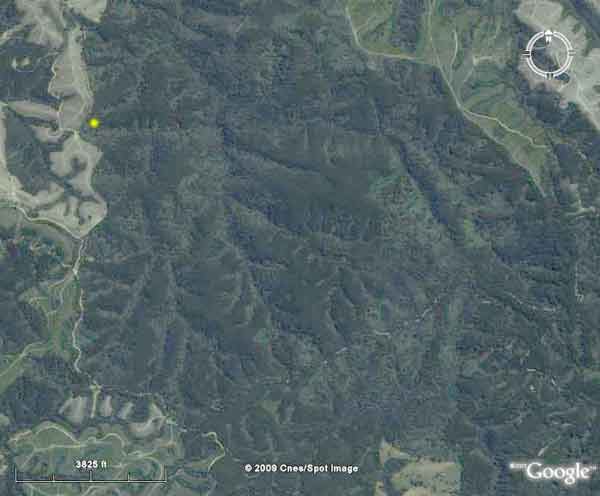
First entry point into College Creek Feb 13 2009
(marked in yellow).
More images here

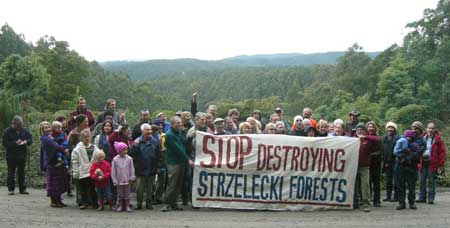
June 29, 2008: 100+ concerned residents rally to save College
Creek.
Stronghold of following Slender Fork Ferns on Mainland Australia
is College Creek
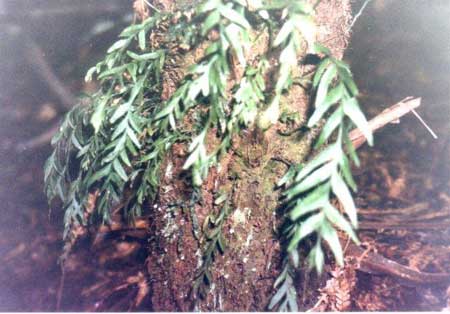
Tmesipteris-elongata (Critically Endangered on Mainland Australia)
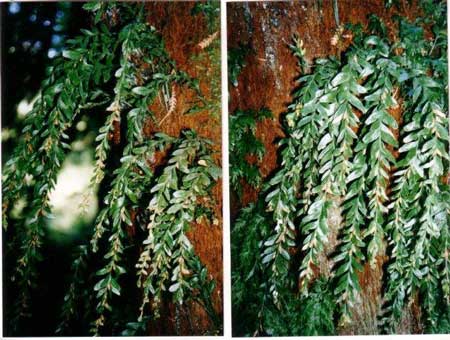
Tmesipteris obliqua (Endangered on Mainland Australia)
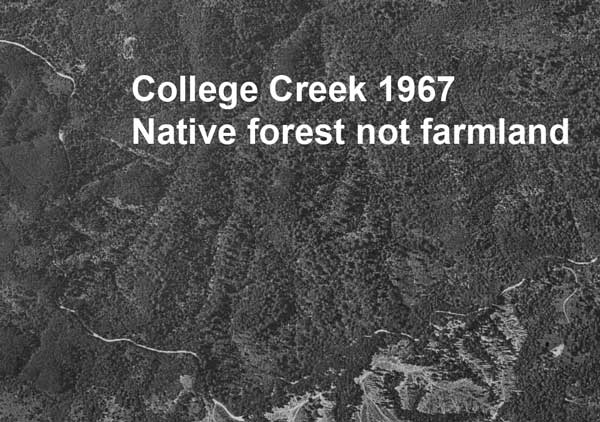
In 1967 College Creek was native forest not cleared farmland.
In 1966 College Creek came under the Wood Pulp Agreement Act, but
logging in the catchment by APM didn't occur until the mid 1970's.
Replanting of Mountain Ash occurred in 1977. This logging would have
put the remaining rainforest under enourmous stress. The logging would
also have 'wiped out' both old growth and younger native forests.
To log such a sensitive rainforest area again is not sustainable.
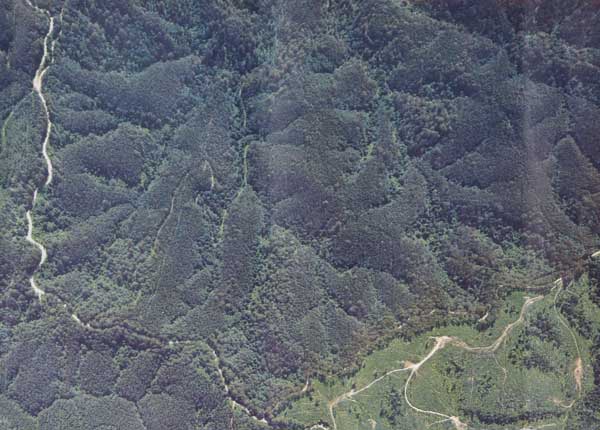
College Creek in the late 1990's
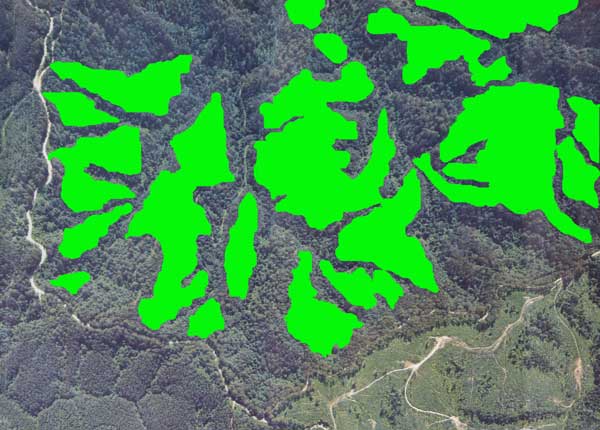
Likely logged areas if Hancock log College Creek 2008.
College Creek
Cool Temperate Rainforest and Wet Forest Buffers now threatened May
2008
For further details also go to;
see
australianpaper watch website
see
australianpaperwatch website (2)
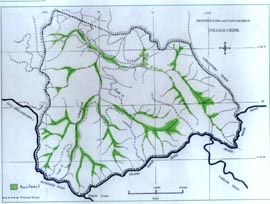 College
Creek and the surrounding catchment was controlled by PaperlinX - Australian
Paper Plantations (APP) (ex-Amcor, ex - Australian Paper Manufacturers)
up until August 2001, when Hancock consumed the assets of APP. College
Creek and the surrounding catchment was controlled by PaperlinX - Australian
Paper Plantations (APP) (ex-Amcor, ex - Australian Paper Manufacturers)
up until August 2001, when Hancock consumed the assets of APP.
Much of the catchment
is actually Crown Land (leased from the Crown) and was going to be the
site of an Agricultural College in the 1940's. The more sensitive areas
of the catchment are leased from the Government to Hancock approximately
until the year 2030.
During 1998/99
a number of myrtle beech have died from myrtle wilt. Most of these trees
were along Track 12 and occurred as a result of track maintenance work
and erosion.
Some trees in
Tributary Four also have myrtle wilt. This is a tributary damaged during
plantation operations during the late 1980s.
In a number of
areas damaged by plantation work, there is vigorous regeneration of
myrtle beech and southern sassafras on the fringes of the plantation
and on tracks.
College Creek Catchment - Paperlinx leasehold.
The College Creek catchment is unusual because of its;
* Location. A northerly facing aspect and the significance of its flora
and fauna.
* The extent of Cool Temperate Rainforest, listed under schedule 3
of the Flora and Fauna Guarantee Act, is larger than that contained
within Tarra Bulga National Park.
*The area is mapped as an endangered and rare Ecological Vegetation
Community, EVC, in Victoria.
Rare and vascular plant species identified by the Department of Natural
Resources and Environment (DNRE) botanists and plant specimens lodged
with the Victorian Herbarium.
* Slender Cyathea cunninghamii Rr (and Skirted Tree Ferns to be listed)
- Rare in Australia and rare in Victoria.
* The stronghold in Victoria for the Slender Fork fern, Tmesipteris
elongata Rv - Rare (in Australia) and vulnerable (in Victoria) abd is
known in only 3 localities in Australia.
* Oval Fork fern Tmesipteris ovata r-Rare in Victoria. State Significance.
* River Hook sedge Unicia nemoralis r-Rare in Victoria.
Rare Fauna includes identified by samples sent to Barbara Triggs and
DNRE Zoologists identifying recorded Owl calls.
* The Broad tooth-rat with a restricted habitat and disjunct distribution
in Victoria.
* Strzelecki (endemic) Koala.
* Yellow-bellied Glider (chewballs and sighting). State significance
outside its recorded range. Requires further verification.
* Powerful Owl - threatened species listed under Schedule 2 of the Flora
and Fauna Guarantee Act. dependent upon hollow bearing trees.
* The Strzelecki burrowing Crayfish provisional listing under Schedule
2 of the Flora and Fauna Guarantee Act.
Many species of arboreal mammals are restricted to mature vegetation
stands, eg Mt. Brushtain Possum, Bobuck, Yellow-bellied and Greater
Gliders. These mammals are all dependent upon hollow bearing trees,
which take over 100 years to form.
Gliders, Koalas and several bat species are sensitive to clearfelling
and may die during clearfelling operations.
The density of these mammals affects the abundance of predators such
as the Powerful Owl.
The species diversity and age composition of forests are determinants
of the faunal composition of the forests.
Clearfelling chnages floristic composition of the overstorey and short
rotations select against favoured tree species of many mammal, forest
and woodland birds.
Recent listing on Schedule 3 of the Flora and Fauna Guarantee Act of
Human activity which results in artificially elevated or epidemic levels
of Myrtle Wilt within Nothofagus-dominated Cool Temperate Rainforest.
A disease fatal to all infected trees.
Listing under Schedule 3 of the Flora and Fauna Guarantee Act, Habitat
Fragmentation as a Threatening Process for Fauna in Victoria.
College Creek Catchment was designated to be of State Significance.
Bill Peel Rainforest and Cool Temperate Mixed Forest of Victoria. DNRE.
College Creek catchment is the last substantial area within APP land
holdings in the Strzeleckis, which contains Cool Temperate Rainforest.
It forms a natural linking corridor between the Agnes and Franklin Catchments,
West Branch Morwell River, Albert River, Jack River, South Middle Creek,
Merriman Creek to Tarra Bulga National Park.
Slender and
skirted tree ferns
All tributaries
of College Creek contain numerous examples of slender and skirted tree
ferns. These tree ferns are classified as rare in Australia and Victoria
and are included in Schedule 2 of the Flora and Fauna Guarantee Act
1988.
Tmesipteris elongata
is known only in two localities in Victoria, in South Gippsland and
the Otway Ranges. This fem grows on the trunks of soft tree ferns and
is found on two tributaries of College Creek. One tributary has over
35 tree ferns containing colonies of this fern and the other about 12
tree ferns.
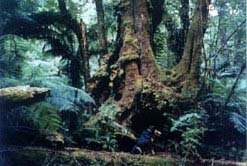 Another
example of rare flora found within College Creek is River Hook Sedge. Another
example of rare flora found within College Creek is River Hook Sedge.
Gypsy fern and
Weeping Spleenwort, though not classified as rare, are dependent on
rainforests for their survival. They, too, are found in College Creek.
Fauna Habitat
English's Corner
(College Creek) was selected as having local and scientific interest
by Mansergh and Norris in 1982. It was selected because it was one of
two localities south of the Princes Highway where the Broad-toothed
Rat has been recorded. This is a rare animal in Victoria with a restricted
and disjunct distribution.
College Creek
also contains a large population of Strzelecki koalas. It is very important
that their habitat be protected because of their genetic variability.
The Powerful Owl
has also been taped at College Creek. It is listed under schedule 2@
of the Flora and Fauna Guarantee Act 1988 and is totally dependent on
hollow- bearing trees.
 Other
species recorded in 1996/97 from scat and hair tube samples analysed
by Barbara Triggs, Genoa, were: Long-nosed Bandicoots, Brushtail Possum,
Mountain Bobuck, Ringtail Possum, Yellow-bellied Glider (chew balls),
Sugar Glider, Black Wallaby, Brown Antechinus, Dusky Antechinus, Bush
Rat, Swamp Rat, Water Rat, Wombat and Short-beaked Echidna. Greater
Gliders were recorded in this catchment in 1982. Other
species recorded in 1996/97 from scat and hair tube samples analysed
by Barbara Triggs, Genoa, were: Long-nosed Bandicoots, Brushtail Possum,
Mountain Bobuck, Ringtail Possum, Yellow-bellied Glider (chew balls),
Sugar Glider, Black Wallaby, Brown Antechinus, Dusky Antechinus, Bush
Rat, Swamp Rat, Water Rat, Wombat and Short-beaked Echidna. Greater
Gliders were recorded in this catchment in 1982.
There are still
areas of mature age mountain ash, mountain grey and messmate in this
catchment. There is also a rich understorey of Blackwood, Hazel pomaderris,
Austral Mulberry and Blanket Lead in much of this catchment. It is essential
that this remaining diversity of age and species of eucalypts and other
native vegetation be retained if the native fauna are to survive.
|











